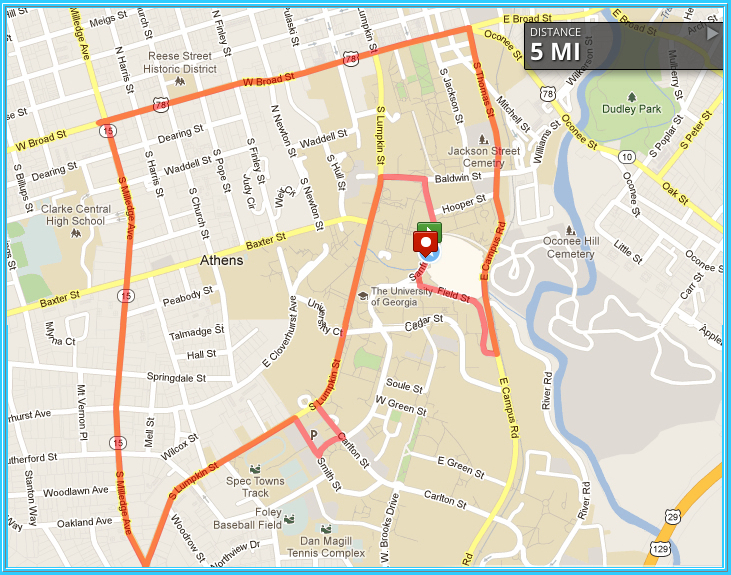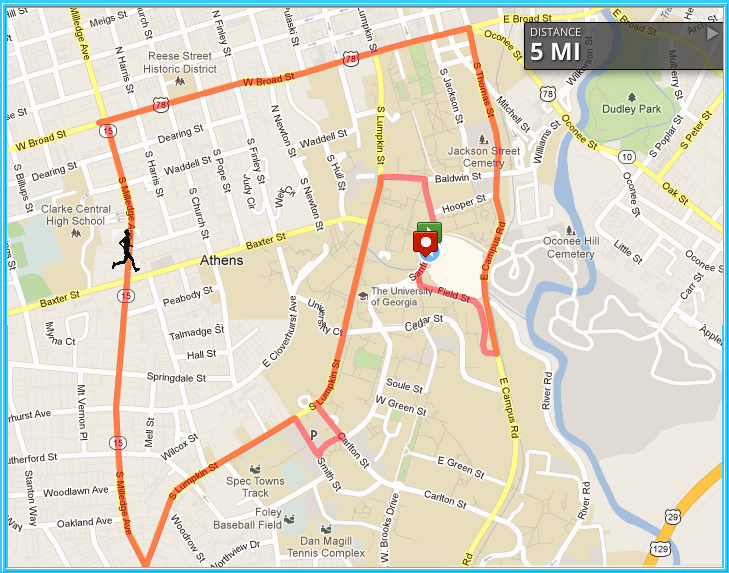

Kate Berryman
cavaleri@uga.edu
*Please make sure your browser is maxiumized to view this write up;
You have just moved to Athens and have decided you want to go for a jog. Since you are new to Athens and want to see as much of campus as you can. You ask a friend where to run and they map out a route for you starting on the Bridge in between Tate Center and Sanford Stadium. They make a map for you that first leads you down north by Park Hall and then down Lumkin Street, taking a small detour down Carlton to run by Stegman Coliseum. Then back to Lumpkin, the route takes you past the track and into Five Points. Then, you turn and head down Milledge Avenue, past all of the sorority and fraturnity houses, all the way to the Varsity. Next, take a right on Broard Street and run through downtown, past the arch, taking a right on South Thomas and continue down East Campus Road. Now, you see the backside of the Sanford Stadium, and turn to run down Field Street. Finally, one last right and you finish on the Bridge where you started.

This is exactly 5 miles. You begin by jogging and enjoying the sights of your home for the next few years and time begins to get away from you. You realize that you have to speed up in order to make it to dinner on time.
The first part of the run, you ran at a rate of 10 minutes per mile. Once you realized you needed to speed up, you began to run at a rate of 8 minutes per mile. It took you 45 minutes to run the entire route. Around what UGA landmark did you have to change your pace?
In our problem we have 2 different rate*time ratios.
Since you ran for 5 miles, we will plot the point (5, 0) on the x-axis and represent miles with the letter m. Next, we will use the y-axis to represent minutes and plot the point (0, 45), because you ran for a total of 45 minutes. We will use t to represent minutes.
Now, since we have 2 differate time*rate ratios, we should begin with the time*rate ratio that of which you started jogging. You beings at our orgin (0,0) and run a mile every minute. Therefore, if you have run one mile, 10 minutes has elapsed. Another way to think about it, is if you have run .1 of a mile per minute. Let's plot some points to see the your progress.
Since m=miles and t=minutes, then our points will be (.1m, t). We get
If you run for 5 minutes, you ran . 5 miles or (5, 0.5).
If you run for 10 minutes, you ran 1 mile or (10, 1).
If you run 15 minues you ran 1.5 miles or (15, 1.5).
If you kept this pace for the entire run, you would run 5 miles in 50 minutes or (50, 5).
Therefore, for every .1 mile you run, a minutes has elapsed. So, we can use the equation m = .1t.
Now, lets graph this line by contructing a line through these points.

Now, we must look at the second time*rate ratio. Now you are running 8 minutes per mile or .125 miles per minute. We will start at the finish point and consider it our new orgin. So we will start at (5, 45). We will denote this as m' and t'. Let's use the same process and plot some points.
However, we have to plot this in terms of our new orgin. Since our new orgin is (0',0'), which is at the point (5, 45).
So if you run for 5 minutes, you have run .625 miles or (50, 5.625).
If you run for 10 minutes, you have run 1.25 miles or (55, 6.25).
If you run for 15 minutes, you have run 1.875 miles or (60, 6.875).
If you ran the entire route at the pace, you would run 5 miles in 40 minutes or (85, 9.6)
So if you run for t' minutes, then you will run for .125t'. Therefore, our equation is m' = .125t'. Now, lets graph this line.

Now, how do we find what UGA landmark you are running by when you realize you need to pick up the pace in order to make it to dinner on time? We must find the intersection of these to lines.
To do this we look at our 2 equations: m = .1t and m = .125t'. We must put m = .125t' in terms of m and t. Let's look at our variable points (m, t). Let's drop a perpendicular line to our y-axis. How do we get the length of t' in terms of the original orgin? We know that 45 is fixed and t is also a variable point which is the entire length from the original orgin, then t' is equal to t minus 45 or:
t'=t-45
Similiarly, we drop a perpendicular line from (m',t') to the x-axis. To get the length of m' in terms of the original orgin, we remember that 5 miles is fixed and that m is also a variable point which is the entire length from the original orgin. Therefore m' is equal to m-5 or:
m'=m-5
Now, all we have to do is substitute what we found t' and m' to be back into m'=.125t'.
m'=.8t'
(m-5)=.125(t-45)
This gives us the point slope formula! Now to solve:
m-5=.125t-5.565
m=.125t-.625
Since we have found m in terms of t, lets subsitute in .125t-.625 into our other rate*time ratio of m = .1t:
m = .1t
.125t - .625 = .1t
.125t - .1t = .625
.025t=.625
t = 25
We found one coordinate of our intersection. To find the other we use t = 8 and substitute:
m = .1t
m = .1(25)
m = 2.5
Therefore, our intersection point is (25, 2.5).
So, we see that you jogged at 10 miles per minute for 25 minutes and then speed up to 8 miles per minute for the last 20 minutes. When you speed up, you are running down Milledge Avenue and have just crossed over Baxter Street.

Click the joggers to see a GSP files and check to see if we are correct!
| 8 Minute Mile | 10 Minute Mile | When you change pace! |